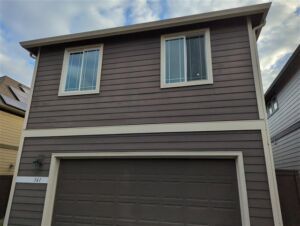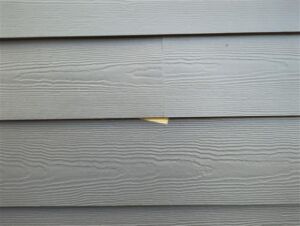
As with all building materials, proper installation of the siding is crucial to ensure the building’s longevity, structural integrity, and aesthetic appeal. Incorrectly installed siding will often lose some or all of its benefits and can because the source of problems.
The purpose of siding is to shed water, typically in the form of rain, and help protect the structure of the home from moisture intrusion. Incorrectly installed siding can do the opposite. It can trap moisture against the wood framing of the wall and result in worse damage than what would have happened if the siding had been missing entirely. Trapped moisture can lead to wood rot, mold growth, and structural damage. It is not uncommon to find significant damage hidden behind poorly installed siding. The cost of repairs is almost always significantly higher than what it would have cost to install the siding correctly in the first place.

Another common installation mistake is incorrect fastening. In order for the siding to perform as intended, the proper fasteners must be used and they must the installed correctly. These requirements are published by the manufacturer and are also commonly included in the building code. Often, we find that fasteners have been over-driven or under-driven. Both of these conditions are improper. The siding must the nailed tight enough to hold it in place without movement, but not so tight that it causes the siding to crack. Fasteners must also be installed in the correct place. Failure to do so can mean that fasteners are visible where they should not be, or they are not performing as intended.
If the manufacturer guidelines for spacing are not followed, siding will often bulge and buckle, leading to a poor visual appearance and a compromised installation. Fiber cement, like any building material, expands and contracts in response to temperature variations. Failure to accommodate these natural movements can result in warping, buckling, or cracking of the siding. Well-installed siding will account for future expansion and contraction. Sometimes, gaps that are too large are left between pieces of siding. This not only looks bad, but it increases the risk of moisture intrusion at these gaps. Inadequate fastening will typically result in loose siding panels, which increases the risk of damage during high winds or other severe weather events.
It is also important to consider that the manufacturer warranty will usually not cover poor or improper installation. In fact, failure to follow manufacturer guidelines will typically void the warranty. This means that the manufacturer may deny a warranty claim based solely on the fact that the siding was not installed as intended. It is critical that all guidelines are adhered to by the manufacturer to ensure that any warranties remain in effect.
In conclusion, the consequences of incorrectly installed fiber cement siding are varied and can be significant. Investing the time and the resources needed to ensure a proper installation is a proactive measure that will pay off in the long run.
You can learn more about how to install fiber cement siding here:
